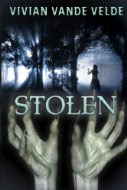 Sullivan, Laura. Under the Green Hill. New York: Henry Holt and Company, 2010. Print.
Sullivan, Laura. Under the Green Hill. New York: Henry Holt and Company, 2010. Print.[Book cover credit: librarything.com/work/10043234]
Booktalk:
"It's like in The Lion, the Witch and the Whachamacallit," Silly said, opening the door.When a dangerous fever breaks out in the States, the Morgan children: Rowan, Meg, Silly, and James, are sent to England to stay with relatives for the summer. And haughty Finn and allergy-stricken Dickie are going with them. As they head to the Rookery, their great-aunt and -uncle's house, the Morgan children expect to spend a long summer in the company of tiresome elderly people. Finn's more concerned about the lack of electricity and Dickie's worried about all the pollen in those famous English gardens. Needless to say, none of them are excited. But when they get to the Rookery, they find a house of busy people getting ready for a midnight festival and themselves packed off to bed, forbidden to leave the grounds. Nothing is more exiting than that which is forbidden, so the Morgans, Finn, and Dickie sneak out to join the festivities, and what they find will change the course of the summer and possibly their lives.
"Wardrobe," Meg said.
"Yup, that's it. Look, it's full of furs, too, just like the one in the book. I wonder if there's a passageway to a secret world."
"We have enough to do here with the fairies without finding another world full of trouble," Meg said testily.
p.123
Review:
As you may have guessed from this blog's title and header, I'm a bit partial to kids in unfamiliar old houses who stumble upon magical worlds. Extra points if that old house is in the English countryside. Extra, extra points if the kids get caught up in an epic war requiring brave heroics. There was never any doubt in my mind that I would love Under the Green Hill.
I want to be so very grown-up and objective and say that what I found so attractive in this book was its own sense of place in and reverence to the tradition of books about kids in unfamiliar old houses, so on and so forth. Or that I loved the allusions to other fairy/faerie stories that I caught but will probably fly over the heads of young readers. Or that I was excited about a middle grade book featuring a position of power passed down through the maternal line, with almost inconsequential (but loved!) husbands marrying into the family to help produce the all important female heir and spare. Or even that I was enchanted by Sullivan's use of language. For example:
Dickie could tell it was extraordinary just from the smell. An odor of knowledge permeated the air, ghosts of arcane secrets wafted about by the breeze the children made when they opened the door. Here were books more rare than any first editions. ... The air seemed stale, as though no one had visited that room in decades. But, oddly, though there was dust on all visible surfaces, the library didn't make Dickie sneeze. Books have their own peculiar kind of dustiness, which didn't catch in his nose the same way cat's hair or thistle pollen might.I could say all of that, and it would all be true (especially that last one). But what really made me fall in love with Under the Green Hill was the story, pure and simple. I'm a sucker for a good fantasy adventure, and this one is full of that goodness: a beautiful setting that is recognizable but still full of fantastical elements, betrayal, swamp monsters, life and death stakes, war-training, a wise benefactress who one can only hope will make everything okay, an enemy that isn't so evil that anyone really wants to kill him, a sensible sister who tries to be the voice of reason, and a brother hell-bent on grand acts of heroism. Plus an added bonus (that I'm also a sucker for): a selkie!
p.119
So Finn, Dickie, and even youngest brother James are a bit underdeveloped. That's okay; they each serve their purpose in the story, hindering or helping the rest of the Morgans along. There's also a little ambiguity in the beginning about when this story is set. It feels like it should be set in the past, between World Wars perhaps, what with the incurable fever ravaging America's children and names like Finn, Rowan and Dickie, but Finn despairs about the DVDs and video games he brought with him to England but can't use since the Rookery has no electricity. It's also possible that I projected a former time on a book whose time period should be last week. Regardless, time period ceased to matter once all the children reached the Rookery and the real story started.
In case you missed it the first two times I said it, I loved this book and I think you all should read it! More professionally, I think other fantasy adventure readers are sure to enjoy it, and it will be an immediate hit with readers looking for something to read once they've run out of Narnia books.
Under the Green Hill is available now, and its sequel Guardian of the Green Hill will be available this fall!
Book source: Review copy provided by the publisher.
Links to Amazon.com may be affiliate links for the Amazon Associates program. If you buy something through this link, I may receive a referral fee.
















